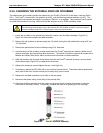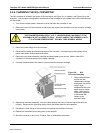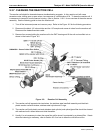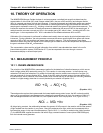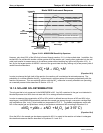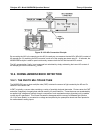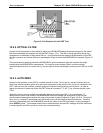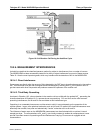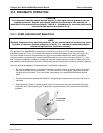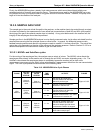
Teledyne API - Model 200EH/EM Operation Manual Theory of Operation
189
10. THEORY OF OPERATION
The M200EH/EM Nitrogen Oxides Analyzer is a microprocessor controlled instrument that determines the
concentration of nitric oxide (NO), total nitrogen oxides (NO
X
, the sum of NO and NO
2
) and nitrogen dioxide
(NO
2
) in a sample gas drawn through the instrument. It requires that sample and calibration gases are supplied
at ambient atmospheric pressure in order to establish a constant gas flow through the reaction cell where the
sample gas is exposed to ozone (O
3
), initiating a chemical reaction that gives off light (chemiluminescence). The
instrument measures the amount of chemiluminescence to determine the amount of NO in the sample gas. A
catalytic-reactive converter converts any NO
2
in the sample gas to NO, which is then – including the NO in the
sample gas – is then reported as NO
X
. NO
2
is calculated as the difference between NO
X
and NO.
Calibration of the instrument is performed in software and usually does not require physical adjustments to the
instrument. During calibration, the microprocessor measures the sensor output signal when gases with known
amounts of NO or NO
2
are supplied and stores these results in memory. The microprocessor uses these
calibration values along with the signal from the sample gas and data of the current temperature and pressure of
the gas to calculate a final NO
X
concentration.
The concentration values and the original information from which it was calculated are stored in the unit’s
internal data acquisition system (iDAS Section 6.7.2) and are reported to the user through a vacuum
fluorescence displa
y or several output ports.
10.1. MEASUREMENT PRINCIPLE
10.1.1. CHEMILUMINESCENCE
The principle of the M200EH/EM’s measurement method is the detection of chemiluminescence, which occurs
when nitrogen oxide (NO) reacts with ozone (O
3
)
.
This reaction is a two-step process. In the first step, one
molecule of NO and one molecule of O
3
collide and chemically react to produce one molecule of oxygen (O
2
)
and one molecule of nitrogen dioxide (NO
2
). Some of the NO
2
retains a certain amount of excess energy from
the collision and, hence, remains in an excited state, which means that one of the electrons of the NO
2
molecule
resides in a higher energy state than is normal (denoted by an asterisk in Equation 10-1).
223
+→+ ONOONO
*
(Equation 10-1)
Thermodynamics requires that systems seek the lowest stable energy state, hence, the NO
2
molecule quickly
returns to its ground state in a subsequent step, releasing the excess energy in form of a quantum of light (h)
with wavelengths between 600 and 3000 nm, with a peak at about 1200 nm (Equation 10-2, Figure 10-10-1).
νhNONO +
2
*
2
→
(Equation 10-2)
All things being constant, the relationship between the amount of NO present in the reaction cell and the amount
of light emitted from the reaction is very linear. More NO produces more light, which can be measured with a
light-sensitive sensor in the near-infrared spectrum (Figure 10-10-1). In order to maximize the yield of reaction
(1), the M2
00EH/EM supplies the reaction cell with a l
arge, constant excess of ozone (about 3000-5000 ppm)
from the internal ozone generator.
04521C (DCN5731)




